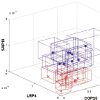Abstract
Background
One goal of gene expression profiling is to identify signature genes that robustly distinguish different types or grades of tumors. Several tumor classifiers based on expression profiling have been proposed using microarray technique. Due to important differences in the probabilistic models of microarray and SAGE technologies, it is important to develop suitable techniques to select specific genes from SAGE measurements.
Results
A new framework to select specific genes that distinguish different biological states based on the analysis of SAGE data is proposed. The new framework applies the bolstered error for the identification of strong genes that separate the biological states in a feature space defined by the gene expression of a training set. Credibility intervals defined from a probabilistic model of SAGE measurements are used to identify the genes that distinguish the different states with more reliability among all gene groups selected by the strong genes method. A score taking into account the credibility and the bolstered error values in order to rank the groups of considered genes is proposed. Results obtained using SAGE data from gliomas are presented, thus corroborating the introduced methodology.
Conclusion
The model representing counting data, such as SAGE, provides additional statistical information that allows a more robust analysis. The additional statistical information provided by the probabilistic model is incorporated in the methodology described in the paper. The introduced method is suitable to identify signature genes that lead to a good separation of the biological states using SAGE and may be adapted for other counting methods such as Massive Parallel Signature Sequencing (MPSS) or the recent Sequencing-By-Synthesis (SBS) technique. Some of such genes identified by the proposed method may be useful to generate classifiers.
